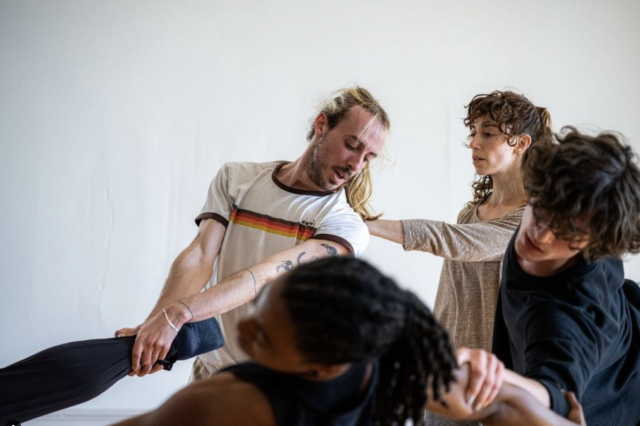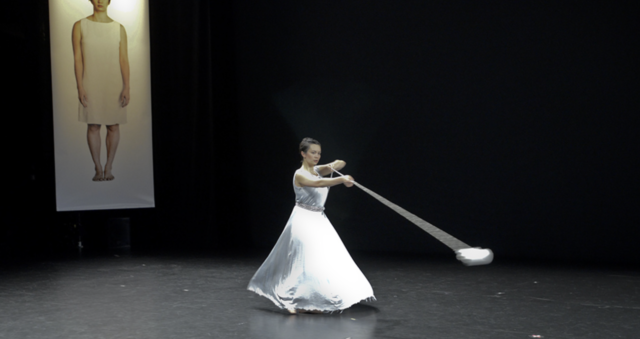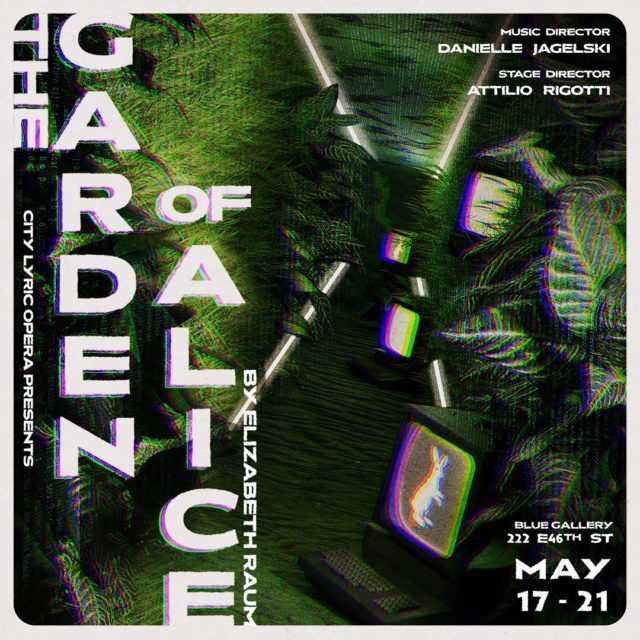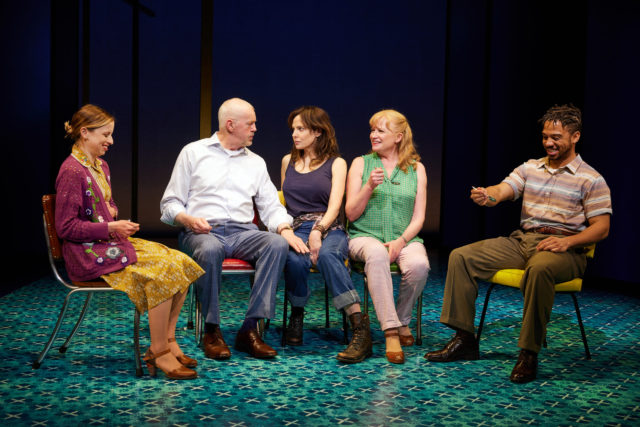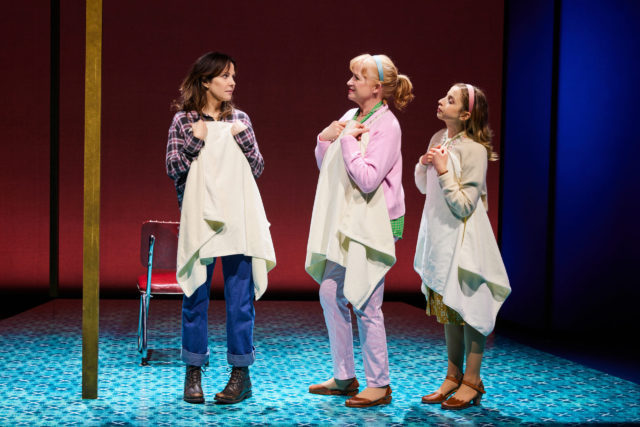
Ann all-star cast of women create mayhem in Selina Fillinger’s POTUS(photo by Paul Kolnik)
POTUS: OR, BEHIND EVERY GREAT DUMBASS ARE SEVEN WOMEN TRYING TO KEEP HIM ALIVE
Shubert Theatre
225 West Forty-Fourth St. between Broadway & Eighth Ave
Tuesday – Sunday through August 14, $39-$250
potusbway.com
I can’t remember the last time I consistently laughed so long and hard at the theater. For 110 minutes — including an intermission during which the joyous tears kept falling as we rehashed what we had just experienced in the first act — Selina Fillinger’s outrageous farce, POTUS: Or, Behind Every Great Dumbass Are Seven Women Trying to Keep Him Alive, had everyone in the Shubert Theatre rolling in the aisles. It’s the funniest play on Broadway in years, but what makes it truly exceptional is that it also has a lot to say about the potential end of the white male patriarchy in America.
The very first word of the play is the “c” slur, the most derogatory term a woman can be called. That’s what the president called his wife, Margaret (Vanessa Williams), at a press conference in front of the world — and the first lady herself. His casual insult sets into motion the behind-the-scenes machinations inside the White House, which is run by his harried chief of staff, Harriet (Julie White), a “walking kegel” with a mannish haircut, and his humorless press secretary, Jean (Suzy Nakamura), who finds turtlenecks to be universally flattering. They rev up to deal with the immediate fallout, but that’s only the start of their berserk day.
Time magazine journalist Chris (Lilli Cooper) is in the West Wing, breast pumps pumping away, as she prepares to interview Margaret for the Women of Excellence series. The young and perky Dusty (Julianne Hough) is wandering around spewing blue vomit and explaining that the president is waiting for her, but no one knows who she is. Stephanie (Rachel Dratch), his hapless secretary and the low dog in the pack, has a photographic memory and speaks five languages, but she’s terrified that Dusty has been called in to replace her. And then Bernadette (Lea DeLaria), the president’s drug-dealing sister and Jean’s former lover, surprises everybody when she suddenly arrives from prison with an ankle monitor, claiming that her brother has pardoned her.
“We’ve talked about this! You can’t pardon someone just because she’s your baby sister!” Margaret says to Harriet. “Our ratings would plummet! We would be crucified! She’s wanted in three countries, Harry. . . . Not to mention all the holidays we’d have to start spending with her if she were to get out — You know, Bernadette bought my daughter a dildo for her sixteenth birthday? And stole my ruby earrings, probably wears them as nipple piercings now.”
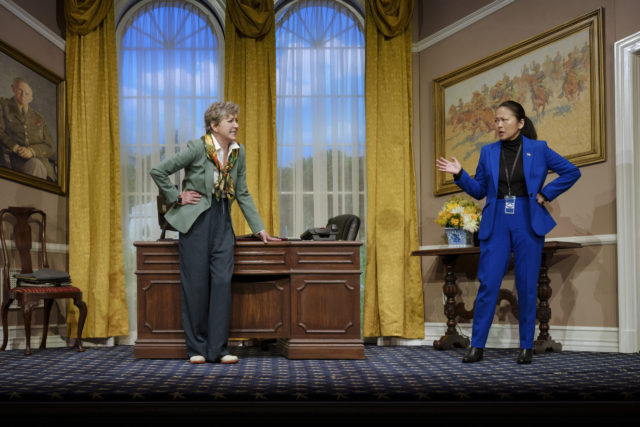
Harriet (Julie White) and Jean (Suzy Nakamura) have to negotiate around presidential ass play in Broadway farce (photo by Paul Kolnik)
Harriet and Jean are also dealing with an important endorsement POTUS is scheduled to make, a speech he has to give to the FML (er, Female Models of Leadership Council), and the anal abscess that is preventing him from sitting down.
Jean: How does a person even get an anal abscess?
Harriet: Jerry told him it can happen sometimes from ass play. . . . Ass play. When it’s rough. Ass play.
Jean: I know what ass play is
Harriet: When it’s rough ass play.
Jean: Stop saying ass play. . . . Is that particular activity a plausible cause for this anal abscess?
Harriet: How would I know?
Jean: You’re his right-hand.
Harriet: Not for that activity.
Soon Stephanie is floating through the White House covered in post-it notes and blood with a pink inflatable donut around her waist as the seven women have to band together if they ever want to get out of the West Wing alive, or at least with any remaining stitch of dignity.

Dusty (Julianne Hough), Bernadette (Lea DeLaria), and Jean (Suzy Nakamura) all have different agendas in hysterical comedy (photo by Paul Kolnick)
In a script note, Fillinger (Something Clean, Faceless, The Armor Plays: Cinched/Strapped), who is only twenty-eight, writes, “At least three of these women should be WOC. Actors can be cis, trans, or non-binary. Age is flexible. Beauty is subjective. So long as they’re fast, fierce, and fucking hilarious.” All seven actors are indeed fast, fierce, and fucking hilarious as the nonstop laughs keep swirling past at such a dizzying pace that you’re likely to miss more than a few. Bernadette, upon meeting Dusty, who has a blue mouth: “What’d you do — blow a Smurf? . . . I banged one of those Blue Man guys once — you know, in my experimental phase: stamina like a bull but I was queefing cobalt for days.” Jean: “Is this day about to become an oozing pustule on the anus of my week?” Margaret to Bernadette: “I should have known you were here by the smell of lies and yeast infection.”
But they’re also not past criticizing their own administration. “I don’t think a government as cozy with Saudi Arabia as Bahrain’s can really pass judgment on ours,” Jean says after hearing that “Bahrain is pissy” about the president’s use of the “c” word about his wife.
Five-time Tony winner Susan Stroman, who has directed and/or choreographed such musicals as Crazy for You, Show Boat, The Music Man, and The Producers, brings that sensibility to Potus; the actors’ movements are so carefully choreographed that it’s almost like a whirlwind dance, and several times, during extremely frantic moments, the performers, in Linda Cho’s colorful costumes and Cookie Jordan’s fab hair and wigs, aren’t afraid to put their bodies in harm’s way if they don’t hit their marks just right, filling each minute with added tension. Beowulf Boritt’s spectacular revolving set takes us from the press briefing room to the bathroom to various offices — but never inside the Oval itself, a space that is sadly still occupied by men only.

Chris (Lilli Cooper) and Margaret (Vanessa Williams) are not sure what Stephanie (Rachel Dratch) is up to in the West Wing (photo by Paul Kolnik)
In their Broadway debuts, Emmy winner Hough (Footloose, Dancing with the Stars) holds her own with the all-star veteran cast, Nakamura (Dr. Ken, The West Wing) stands tough even when up against the wall, and Dratch (SNL, Ripcord) nearly steals the show as she roams the White House on puppy uppers and doggie downers. But Fillinger and Stroman allow plenty of room for anyone to steal any scene, which leads to glorious mayhem from Grammy, Emmy, and Tony nominee Williams (Into the Woods, The Trip to Bountiful), spoofing Michelle Obama; DeLaria (Orange Is the New Black, The Rocky Horror Show) living up to her title of go-to raging butch; Cooper (Tootsie, The Wildness) as a single mother trying to keep her life and career in balance; and Tony winner White (The Little Dog Laughed, Airline Highway) as Harriet, who sacrificed it all so she can now steer a sinking ship. “Room full of men, talking about weapons and war, not a woman in sight,” Harriet points out.
The atmosphere in the Shubert is electric from the very second you enter, with pop songs by woman superstars blasting through the speakers, from Rihanna, Heart, and Annie Lennox to Pat Benatar, L7, and Bikini Kill, a playlist that is referred to as BitchBeats in the show; the centerpiece is Joan Jett’s “I Hate Myself for Loving You,” in which the rock goddess screams out, “Hey man, bet you can’t treat me right / You just don’t know what you was missin’ last night / I wanna see you beggin’, say, ‘Forget it’ just for spite / I think of you every night and day / You took my heart, and you took my pride away.” After POTUS, 1600 Pennsylvania Ave., and Broadway, might never be the same again.

